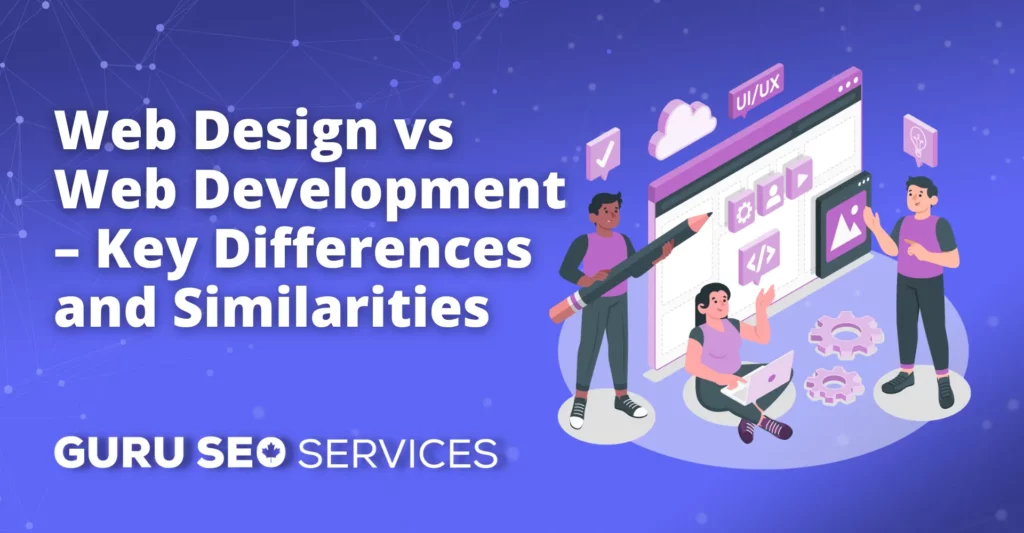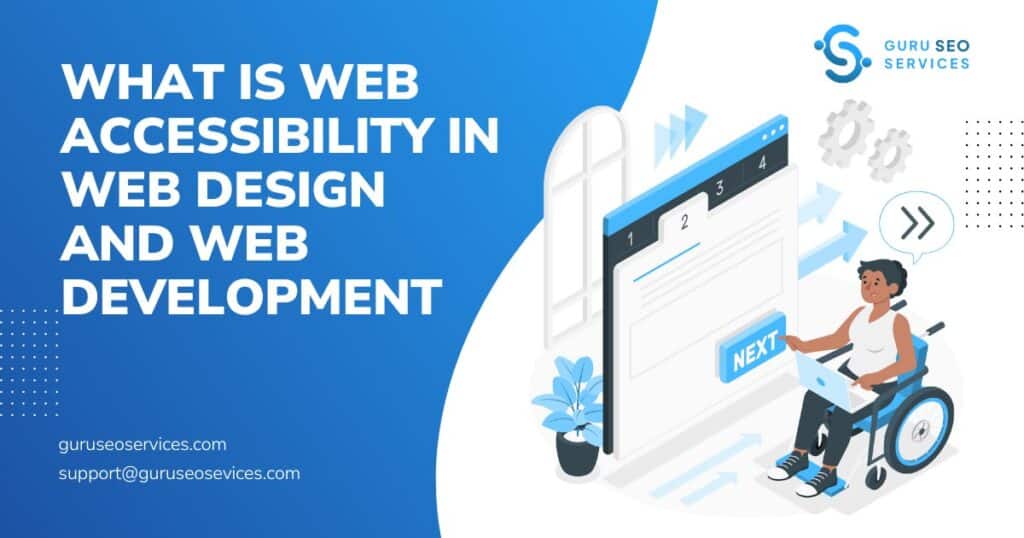Web design vs web development – are they two sides of the same coin or is there more than meets the eye?
Today, we’re breaking down web design vs web development, their differences, similarities, and more. We’ll also get into what web designers and web developers do, what they work on, and how they can help a business grow.
Let’s get into it.
What Is Web Design?
Website design deals with a site’s usability and aesthetic and has many different elements. The goal of web design is to create a site that’s visually appealing, engaging, and functional.
Ultimately, good web design aims to score high points for user experience. A site with successful web design elements is one that has aesthetically pleasing features, is easy to navigate, feels intrinsic to the brand, and above all else – fits with your customer base.
Elements of Web Design
Instead of working behind the scenes on coding, web designers typically work with visual and graphic elements. Let’s look over the key aspects of web design and how they affect a website.
Layout and Design
The layout and design of a website are some of the most impactful elements of a site. These include the arrangement of logos, introduction text, navigation, headers, footers, and additional video or graphical elements.
Not only that but as part of the layout and design, designers are also responsible for keeping up with the latest trends in design. A website’s layout can also include mobile-friendly development options, which a designer will work on and implement with a developer.
Branding and Colours
Choosing the colour scheme of a site is incredibly important, and will depend on many different factors. These include the company’s logo, target audience, and overall preferences.
Graphics
Graphics, logos, photographs, and illustrations are also all parts of web design. A good web designer has a great grasp of colour theory and knows how to integrate a wide range of layouts, colour palettes, and themes into a website.
Hierarchy
If your goal is to attract potential customers, collect user information, or generate sales – website hierarchy will be the key. Knowing where certain website elements should appear and why is critical when designing. What’s more, it’s important to know which graphic elements will be the most appealing as they can make a lasting impression on visitors.
Navigation
Without the proper navigation, potential customers can easily get frustrated with your site and leave. The navigation of a site should be immediately visible, easily accessible, and responsive. What’s more, it should be all those things no matter which devices your customers are using.
Accessibility
Just like navigation, accessibility is what can make or break a website. Even though a big part of the process falls on web development, design plays a crucial role in creating additional graphical and design elements.
Website Speed
During the design process, it’s important to take into account the overall size of the graphics and other design elements because they have a massive effect on the site’s speed. If a site is taking too long to load, you risk increasing its overall bounce rate.
A bounce represents a single-page session on your site and if you want visitors to stay on your site for longer, browse, or maybe shop – you want to keep the bounce rate low.
What Does a Web Designer Do?
A web designer is responsible for creating, designing, and maintaining the visual aspects of a site. They often work with a client or their team to create various layouts and designs for a site.
What’s more, a designer might also be responsible for creating custom graphics, and logos, be involved in user interface design, and more.
Web designers use many different software applications, including Adobe Photoshop, Adobe InDesign, and many others.
What Is Web Development?
Web development centers on the mechanism that allows the site to work correctly. The development brings the designs to life and makes the site functional through coding.
Web development governs all the code that makes a website tick and it’s typically split into two categories: front-end and back-end. The front end deals with writing code that determines how the website displays a designer’s concepts.
On the other hand, the back end has to properly manage the data within a site’s database, enabling it to display on the front end.
Elements of Web Development
Web developers are experts at problem-solving and understanding various programming languages like HTML, CSS, JavaScript, Python, and others. Also, developers will help designers to coordinate efforts to bring a design to life. Here are some of the elements that go into developing a site.
Programming
Regarding web design vs web development, it’s important to note that programming is a staple of development. Through a wide variety of programming languages, developers will take care of building the entire site and publishing it.
SEO
In addition to programming languages, development also tackles SEO or Search Engine Optimization. When developing a new website, it’s important to consider and implement updated SEO tactics to ensure the site is optimized to perform in search engines. A site that’s properly optimized will appear on the first pages of search results for top engines like Google or Bing.
Optimization
Whether you choose to build a website from scratch or use a third-party solution, your site needs to be optimized. The development process will help eliminate any unnecessary code and only use the best elements for the site.
Structure
While design tackles navigation and accessibility, development handles structures. More specifically, it uses properly structured lines of code to ensure your site loads faster and doesn’t get too bogged down. In collaboration with design, development can improve your site speed and reduce your bounce rate.
CMS Operations
CMS or Content Management Systems and e-commerce solutions are now used to make web development easier and more accessible. That’s why in addition to creating sites from scratch, as part of development, new or existing designs can be easily integrated into a CMS of your choice.
What Does a Web Developer Do?
A web developer is responsible for developing the front and back end of a website, and ensuring that it conforms to all design, technical, and accessibility guidelines. They might also be responsible for creating custom solutions or modifications to existing websites.
In addition to creating sites, web developers might also create custom applications for their clients. They typically work with clients to create mockups or prototypes of the websites their clients want to be developed.
Web Design vs Web Development – What’s the Difference?
When it comes to breaking down web design vs web development – there are key differences to note. But above all else, the design aims to add aesthetic appeal, while development seeks to add functionality.
Web development will add functionality to a site, but web design seeks to enhance user experience and make it more appealing overall. However, to ensure the absolute best results, development and design have to come together.
That said, let’s take a look at some other aspects of web design vs web development and why they differ from one another.
Web Designers Create Assets
While designers create visual assets that add aesthetic value to a site, developers are responsible for adding those functionalities. The developers will translate the mockups, wireframes, and other assets made by the designers and turn them into code using CSS, HTML, or JavaScript.
That means that designers are responsible for creating visual assets, while developers use code to make those pop on the website.
Web Developers Write Code
Another area where you can see the difference between web design vs web development is that the former usually isn’t responsible for coding. Of course, there are exceptions, but typically, these things are separate.
Some companies opt to work with “no code” website builders so that the designers can enhance the aesthetics of the site and enhance the user experience without coding.
Web Design Often Costs Less
Traditionally, web design costs less than web development, which means you can expect to pay less for design.
The reason behind the discrepancy is that development requires training, or more specifically coding. What’s more, supply and demand will have an impact on the average costs.
Web Design vs Web Development – What Are the Similarities?
So far, we’ve only delved into the differences between web design vs web development. However, there is a certain overlap between the fields as they both aim to create a viable website experience for users.
Both design and development have a role in creating an engaging user experience and ensuring that customers have a positive association with the website and the brand. While development ensures a site is functioning properly, the design guarantees that customers have an easy-to-navigate experience.
All of that is to say that web design and web development have to work together in unison to develop a cohesive, functional website.
Without development, a website won’t work properly but without design, it’ll feel impersonal or unprofessional. The result of the two fields working together will create an exceptional web experience.









